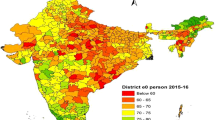Abstract
The objective of this study is to identify individual level factors that determine the use of skilled birth attendants in India. Data from the cross-sectional, population-based NFHS 3 Survey 2005–06 was used. A sample of 31,797 women, aged 15–49 years, who gave births in the 3 months preceding the survey and for whom information was available on most variables, were included in the analysis. Both bivariate and multivariate techniques were used to determine factors associated with the use of skilled attendants at birth. In the study we found that wealth is one of the strongest determinants of skilled birth attendant use, with the poor being at a disadvantage. There are significant differences in the use of skilled delivery care among the urban and rural populations in India. Women in urban areas are more likely to use skilled attendants. Muslim women and women with lower levels of education are also less likely to avail skilled delivery services. The use of skilled care depended significantly on the place of delivery. Women who gave history of antenatal visits were more likely to have skilled attendants at birth. Our analysis demonstrates that there are several financial, social, regional and cultural barriers to skilled birth attendant use in India. Effective strategies need to be planned to generate demand for skilled birth attendants and reduce barriers to care seeking, especially among rural poor.
Similar content being viewed by others
References
World Health Organization. (2007). Maternal mortality in 2005. Estimates developed by WHO, UNICEF, UNFPA, and The World Bank.
Hafez, G. (1998). Maternal mortality: A neglected and socially unjustifiable tragedy. Eastern Mediterranean Health Journal, 4, 7–10.
Starrs, A. (1997). The safe motherhood action agenda: Priorities for the next decade. Report on the safe motherhood technical consultation 18–23 October 1997, Colomba, Sri Lanka, family care international/the inter-agency group for safe motherhood, New York.
AbouZahr, C. (2003). Global burden of maternal death and disability. British Medical Bulletin, 67, 1–11.
Harvey, S. A., Ayabacab, P., Bucaguc, M., Djibrinad, S., Edsona, W. N., Gbangbadee, S., et al. (2004). Skilled birth attendant competence: An initial assessment in four countries, and implications for the safe motherhood movement. International Journal of Gynecology and Obstetrics, 87, 203–210.
de Luc, Bernis, Sherratt, D. R., AbouZahr, Carla, & Van Lerberghe, Wim. (2003). Skilled attendants for pregnancy, childbirth and postnatal care. Bristish Medical Bulletin, 67, 39–57.
UNFPA. (1994–2009). Key actions for further implementation of the program of action of the ICPD-ICPD+5. Retrieved from www.unfpa.org/icpd/icpd5.htm.
Department of Reproductive Health and Research. (2008). World Health Organization. Proportion of births attended by a skilled health worker 2008 updates. Retrieved from www.who.int/reproductive-health Accessed 23 June 2009.
Koblinsky, M., Matthews, Z., Hussein, J., Mavalankar, D., Mridha, M. K., Anwar, I., et al. (2006). On behalf of the lancet maternal survival series steering group. Going to scale with professional skilled care. Lancet, 368, 1377–1386.
Hunt, L. M., Glantz, N. M., & Halperin, D. C. (2002). Childbirth care seeking behaviour in Chiapas. Health Care for Women International, 23, 98–118.
Yanagisawa, S., Oum, S., & Wakai, S. (2006). Determinants of skilled birth attendance in rural Cambodia. Tropical Medicine and International Health, 11(2), 238–251.
Gabrysch, S., & Campbell, M. R. (2009). Still too far to walk: Literature review of the determinants of delivery service use. BMC Pregnancy and Childbirth, 9, 34.
International Institute for Population Sciences (IIPS), Macro International. (2007). National family health survey (NFHS-3), 2005–06: India: Volume I. Mumbai: IIPS.
UNICEF. (2001). Progress since the world summit for children: A statistical review. UNICEF: New York.
Kesterton A. J., Cleland, J., Sloggett, A. & Ronsmans, C. 2010. Institutional delivery in rural India: the relative importance of accessibility and economic status. BMC pregnancy and childbirth, 10: 30.
Author information
Authors and Affiliations
Corresponding author
Rights and permissions
About this article
Cite this article
Hazarika, I. Factors that Determine the Use of Skilled Care During Delivery in India: Implications for Achievement of MDG-5 Targets. Matern Child Health J 15, 1381–1388 (2011). https://doi.org/10.1007/s10995-010-0687-3
Published:
Issue Date:
DOI: https://doi.org/10.1007/s10995-010-0687-3




